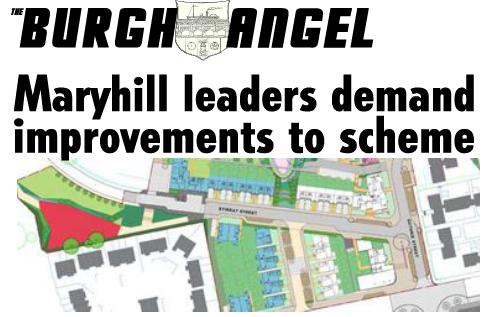A leaked document stamped with the letterhead of the GHA and the Labour run City Council discussing a “Housing Options” pilot project in the North West of Glasgow has scary consequences for the rights of citizens to housing.
Housing Options is the name given to the practice of “gatekeeping” – where citizens who are homeless or facing homelessness are prevented from being able to make a homeless persons application, and so are prevented from being able to readily access social housing. It is a practice which has brought misery to the poorest families in places like inner London, where pressure on dwindling social housing stocks and the abundance of unscrupulous slum landlords in the private rented sector has seen average rents for bedsit flats rise above £750.00 a month.
We spoke to a specialist debt advisor and welfare rights worker who is an expert on dodgy gatekeeping practices in London, who works in Glasgow and is worried that the sleaziest elements of the cocaine capitalism that led to the banking collapse are being imported and forced onto the Burgh’s residents, and Glasgow’s poorest.
Adrienne told us, “I’ve seen some really terrible stories as a result of gatekeeping. Families who really need social housing are being forced into crazy debts to keep up payments to ruthless landlords because councils will do anything to prevent them making a homeless application. There have been cases where poor people have been driven to the edge as a result of these cruel policies. These policies are an attack on those who need support.”

Private landlords and homeless pressures on families have a long and ugly association.
According to the document the council means to roll this project out from April of this year. Phase 1 will begin in April and end in September. Phase 2 will start in October 2012 before ending in April next year to foisted onto the whole city.
The council document is explicit about the goal of preventing people accessing their right to social housing, despite the very high demand for this type of housing.
“The Housing Options pilot has grown out of a recognition that service delivery for homeless and potentially homeless people needed to change, if we were to balance the growing demands for housing (social housing in particular) against the slow down in supply as a result of the economic situation. Pressure on social housing continues to increase and access to other tenures is contracting, the number of homelessness cases shows no sign of slowing and tailored advice for people who need it is fragmented and difficult to access.”
Pressure on social housing has increased because tens of thousands of social homes have been demolished across the city, which have not been replaced. Despite spiralling poverty in Maryhill we have the slimy spectacle of the social home swick at Maryhill Locks. Hundreds and hundreds of almost 100% social homes have been demolished. The land (worth £100 million) has been given away for free by the council to private developers. Worst of all the plan to replace the hundreds of homes razed to the ground now insists that just 17% of the new houses are to be built for social rent.


Sports cars in the new Maryhill Locks: who the council imagines will live there when they have finished building.
A number of different groups are to be involved in rolling out the project, but it is explicit about “joining the dots” between different services (ie that all housing associations and “other key stakeholders” will be forced to comply) and its being “focussed on the North West area.” We are to be the guinea pig for a plan that has a track record elsewhere of making poorer people’s lives increasingly more stressful and difficult.
“This is about removing the safety net,” Says Adrienne.
As the document states euphemistically, “Housing Options recognises that the availability of social housing is limited and cannot be the answer to everyone’s housing needs. It avoids any initial assumption that a social rented tenancy or homeless application is necessarily the most appropriate solution for a household.”
There is however no mealy-mouthed euphemism about the council’s main goal, from the very first days of the trial of this new treatment. “The expected benefits of the Phase 1 pilot are: … Reduction in number of section 5 referrals.” This is technical speak, but there is no doubting what it means: preventing people from making homelessness applications which result in the right to a socially rented house. Section 5 referrals are the right to a house from homelessness applications – it is a hard won statutory right. The process emerged in response to overwhelming pressure from the tenants movement, who pushed for decades for these rights for citizens.
Shelter, the Homelessness charity, makes clear that the Section 5 homelessness application process is about rights for the individual and their family:-
“Section 5 referrals are the formal means by which local authorities (LAs) can ensure that homeless people are housed by registered social landlords (RSLs). […] Scottish Executive guidance makes clear that, when a section 5 referral is made, the only reason a RSL can reject the referral is if appropriate accommodation will not be available within a reasonable period, usually six weeks. Where LAs and RSLs cannot agree a referral then the decision can go to an arbiter. ”
The Burgh Angel is deeply concerned about the attacks on citizens rights, and the stress this is putting on families. We know that the social home swick in Maryhill has helped to put immense strain on the supply of social housing. This needs to be addressed urgently, and new social homes need to be built to replace the tens of thousands we have lost across Glasgow. However there is not need to take this situation lying down. If you work in housing or homelessness, have been homeless yourself, or just want to discuss this situation, the Burgh Angel would like to hear from you. The attacks on housing are now threatening hard won rights, and this risks placing our families in crisis.
 The Burgh Angel, along with leaders in community based institutions in Maryhill have been concerned about the way that Maryhill Locks developments are to deliver just 17% social homes. As a result a campaign has been launched to bring together different institutions and concerned citizens in the local area. The campaign is meeting with Stephen Curran, the Labour councillor in charge of the scheme, to demand improvements. The group is due to meet with Councillor Curran and officials later in the month. The next Angel will report on any progress from that meeting and reveal details of how
The Burgh Angel, along with leaders in community based institutions in Maryhill have been concerned about the way that Maryhill Locks developments are to deliver just 17% social homes. As a result a campaign has been launched to bring together different institutions and concerned citizens in the local area. The campaign is meeting with Stephen Curran, the Labour councillor in charge of the scheme, to demand improvements. The group is due to meet with Councillor Curran and officials later in the month. The next Angel will report on any progress from that meeting and reveal details of how












